Boeing B-47 Stratojet
| B-47 Stratojet | |
|---|---|
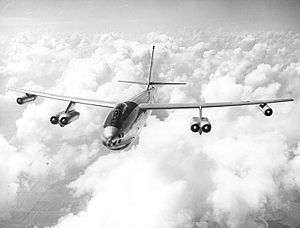 | |
| Boeing B-47 Stratojet in flight. | |
| Role | Strategic bomber/Aerial reconnaissance |
| National origin | United States |
| Manufacturer | Boeing |
| First flight | 17 December 1947 |
| Introduction | June 1951 |
| Retired | 1969, B-47E 1977, EB-47E |
| Primary user | U.S. Air Force |
| Number built | 2,032 |
| Unit cost | |
The Boeing B-47 Stratojet (company Model 450) was an American long range, six-engine, turbojet-powered strategic bomber designed to fly at high subsonic speed and at high altitude to avoid enemy interceptor aircraft. The B-47's primary mission was to drop nuclear bombs on the Soviet Union. With its engines carried in nacelles under the swept wing, the B-47 was a major innovation in post-World War II combat jet design, and contributed to the development of modern jet airliners.
The B-47 entered service with the United States Air Force's Strategic Air Command (SAC) in 1951. It never saw combat as a bomber, but was a mainstay of SAC's bomber strength during the late 1950s and early 1960s, and remained in use as a bomber until 1965. It was also adapted to a number of other missions, including photographic reconnaissance, electronic intelligence and weather reconnaissance, remaining in service as a reconnaissance aircraft until 1969 and as a testbed until 1977.
Development
Origins
The B-47 arose from an informal 1943 requirement for a jet-powered reconnaissance bomber, drawn up by the U.S. Army Air Forces (USAAF) to prompt manufacturers to start research into jet bombers. Boeing was among several companies that responded to this request; its initial design, the Model 424, was basically a scaled-down version of the piston-engined B-29 Superfortress equipped with four jet engines.[2]
In 1944 this initial concept evolved into a formal request-for-proposal to design a new bomber with a maximum speed of 550 mph (890 km/h), a cruise speed of 450 mph (720 km/h), a range of 3,500 mi (5,600 km) and a service ceiling of 45,000 ft (13,700 m).[3] In December 1944, North American Aviation, the Convair Corp., Boeing and the Glenn Martin Company submitted proposals for the new long-range jet bomber. Wind tunnel testing had shown that the drag from the engine installation of the Model 424 was too high, so Boeing's entry was a revised design, the Model 432, with the four engines buried in the forward fuselage.[4]
The USAAF awarded study contracts to all four companies, requiring that North American and Convair concentrate on four-engined designs (to become B-45 and XB-46), while Boeing and Martin were to build six-engined aircraft (the B-47 and XB-48). The powerplant was to be General Electric's new TG-180 turbojet engine.[4]
Swept wings
In May 1945, the von Kármán mission of the Army Air Forces inspected the secret German aeronautics laboratory near Braunschweig. On von Kármán's team was the eminent chief of the technical staff at Boeing, George S. Schairer. He had heard about the controversial swept-wing theory of R. T. Jones at Langley, but seeing models of swept-wing aircraft and extensive supersonic wind-tunnel data generated by the Germans, the concept was decisively confirmed. He wired his home office: "Stop the bomber design", and changed the design of the B-47 wing.[5]
Analysis work by Boeing engineer Vic Ganzer suggested an optimum sweepback angle of about 35 degrees.[6] Boeing's aeronautical engineers modified their Model 432 design to include swept wings and tail, resulting in the "Model 448", which was presented to the USAAF in September 1945. The Model 448 retained its four TG-180 jet engines in its forward fuselage, with two more TG-180s in the rear fuselage. The flush-mounted air intakes for the rear engines were inadequate, while the USAAF disliked the installation of engines within the fuselage, considering it a fire hazard.[4][7]
The engines were moved out to streamlined pods (pylon mounted) under the wings, leading to the next iteration, the Model 450, which featured two TG-180s in a twin pod mounted on a pylon about a third of the way outboard on each wing, plus another engine at each wingtip. The Army Air Force liked this new configuration, and so Boeing's team of engineers continued to refine it, with the outer engines being moved further inboard, to about 3/4 of the wingspan. The thin wings provided no room into which wheels could be retracted, so a "bicycle landing gear" was chosen, with the two main gear assemblies arranged in a tandem configuration and outrigger struts fitted to the inboard engine pods. As the landing gear arrangement made rotation (i.e., lifting the nose during takeoff) impossible, the landing gear was designed so that the aircraft rested on the ground at the proper angle for takeoff.[4][8]
USAAF selects Boeing
The USAAF was very pleased with the refined Model 450 design, and in April 1946, the service ordered two prototypes, to be designated "XB-47".[9] Assembly began in June 1947.
The first XB-47 was rolled out on 12 September 1947,[8] a few days before the USAAF became a separate service, the U.S. Air Force, on 18 September 1947. The XB-47 prototype flew its first flight on 17 December 1947 (the anniversary of the Wright Brothers' first four flights on 17 December 1903), with the test pilots Robert Robbins and Scott Osler at the controls of the aircraft. It flew from Boeing Field in Seattle to the Moses Lake Airfield in central Washington state, in a flight that lasted just 27 minutes,[10][11] with no major problems. Robbins had to pull up the flaps with the "emergency hot wire system", and the "engine fire" warning indicators were falsely lit. Robbins reported that the flight characteristics of the aircraft were good.[12]
In Feb. 1949, Russ Schleeh and Joe Howell "broke all coast-to-coast speed records" flying from Moses Lake Air Force Base to Andrews Air Force Base. They averaged 607.8 miles per hour.[12]:34–36
During early tests of the XB-47 prototype, the canopy came off at high speed, killing pilot Scott Osler.[13] The copilot safely landed the aircraft. This resulted in a canopy redesign, and the hiring of pilot Tex Johnston as chief test pilot.[14]
Second X-model
The second XB-47 (46-066) prototype first took to the air on 21 July 1948 and following its delivery to the USAF in December of that year, it served as a flying test bed until its retirement in 1954. Its final destination was Chanute AFB where it was used as a maintenance and familiarization aircraft.[15]
This second prototype was equipped with much more powerful General Electric J47-GE-3 turbojets with 5,200 lbf (23 kN) of static thrust each.[16] The J47 or "TG-190" was a redesigned version of the TG-180/J35. The first XB-47 prototype was later retrofitted with these engines.
Flight testing of the prototypes was particularly careful and methodical, since the design was new in so many ways. The prototypes initially suffered from "Dutch roll", an instability that caused the aircraft to weave in widening "S" turns. This problem was remedied by the addition of a "yaw damper" control system that applied rudder automatically to damp out the weaving motion. The prototypes also had a tendency to pitch up. This problem was solved by adding small vanes called "vortex generators" onto the wings that caused turbulence to prevent airflow separation.
Boeing test pilot Rob Robbins had originally been skeptical about the XB-47, saying that before the initial flight he had prayed, "Oh God, please help me through the next two hours." The aircraft was "considered to be a radical airplane." Robbins soon realized that he had an extraordinary aircraft.[12]
Chuck Yeager flew a test of the XB-47 later in its development cycle and years later noted that the aircraft was so aerodynamically clean that he had difficulty putting it down on the Edwards lakebed.[17]
Both XB-47 prototypes were test flown at Edwards AFB, however the number one XB-47 (46-065) was disassembled and eventually scrapped by the Air Force in 1954, thus making the number two prototype (46-066) the sole surviving XB-47.
Upon retirement, XB-47 (46-066) was restored and placed on display at the Octave Chanute Aerospace Museum in Rantoul, Illinois where it remained on display until the museum announced it was closing its doors due to financial difficulties in April 2015.[18] In late 2015, the Flight Test Historical Foundation began fundraising efforts to purchase XB-47 (46-066) for relocation to the Flight Test Museum at Edwards AFB. The purchase was completed in August 2016 and the process of disassembly for transport is underway. Once the aircraft arrives, the process of restoration for eventual display at the museum will begin.[19]
X-model competitions
By mid-1948, the Air Force's bomber competition had already been through one iteration, pitting the North American XB-45 against the Convair XB-46. The North American design won that round of the competition; as an interim measure, the USAF decided to put the North American bomber into production on a limited basis as the B-45 Tornado. The expectation was that B-45 production would be terminated if either of the remaining two designs in the competition, the Boeing XB-47 and the Martin XB-48, proved superior. It is sometimes claimed that the final production decision was made as a result of Boeing president Bill Allen inviting USAF General K.B. Wolfe, in charge of bomber production, for a ride on the XB-47.[20] A formal contract for 10 aircraft was signed on 3 September 1948.[21]
Design
Overview

The XB-47, which looked unlike any contemporary bomber, was described by some observers as a "sleek, beautiful outcome that was highly advanced".[22] The 35-degree swept wings were shoulder-mounted, with the twin inboard turbojet engines mounted in neat pods, and the outboard engines tacked under the wings short of the wingtips. With the exception of a change from the shoulder wing configuration to being under the fuselage and cockpit seating to side-by-side, most future airliners would use a similar configuration, with the engines mounted in underwing pylons. This arrangement would reduce the bending moment at the wing roots, saving structural weight. The mass of the engines also acted as counter-flutter weights.
The wing airfoil was identified by Boeing as the BAC 145, but this was actually the NACA 64A(.225)12 mod airfoil.[23] The wing's flexibility was a concern, as it could flex as much as 17.5 ft (5.3 m) at the tip, and major effort was expended to ensure that flight control could be maintained as the wing moved up and down. As it turned out, most of the worries proved unfounded. The aircraft's maximum speed was limited to 425 kn (787 km/h) to avoid control reversal, where aileron inputs by the pilot would cause the wings to twist and produce a roll in the opposite direction to that desired by the pilot.[24] The wings were fitted with a set of Fowler flaps that extended well behind the wing, to enhance lift at slow speeds.[12]:19,47,54,207,213
The XB-47 was designed to carry a crew of three in a pressurized forward compartment: a pilot and copilot, in tandem, in a long fighter-style bubble canopy, and a navigator/bombardier in a compartment in the nose. The copilot doubled as tail gunner (using a remotely controlled, radar-directed tail gun), and the navigator as bombardier. The bubble canopy could pitch up and slide backward, but as the cockpit was high off the ground, crew entrance was through a door and ladder on the underside of the nose. The extreme front of the nose was initially glazed to allow visual navigation and bomb sighting, but this was quickly and increasingly faired over with metal. Almost all production versions had a solid metal nose with no windows. A K-series bombsight provided integrated radar navigation and visual navigation, with the optical portion extending through the nose of the aircraft in a small dome.
Engines and performance
The first prototypes were fitted with General Electric J35 turbojets, the production version of the TG-180, with 3,970 lbf (17.7 kN) of thrust. Early jet engines did not develop good thrust at low speeds, so to help a heavily loaded bomber take off, the XB-47 prototype had provisions for fitting 18 solid-fuel rocket-assisted takeoff (RATO) rockets with 1,000 lbf (4.4 kN) of static thrust each. Fittings for nine such units were built into each side of the rear fuselage, arranged in three rows of three bottles.
The performance of the Model 450 design was projected to be so good that the bomber would be as fast as fighters then on the drawing board, and so the only defensive armament was to be a tail turret with two .50 in (12.7 mm) AN/M2 Browning machine guns, which would in principle be directed by an automatic fire-control system. The two XB-47s were not fitted with the tail turrets as they were engineering and flight test aircraft; indeed, the prototypes had no combat equipment at all. The one problem with this early design was that at higher altitudes where the pure turbojet engines could produce decent fuel economy, the wing was very compromised.
At the top of the B-47's envelope, about 35,000 feet (11,000 m), the B-47 was in "coffin corner".[12]:184 That means that at this level, which produced the most range at most weights due to fuel consumption, there was an envelope of 5 kn (9.3 km/h) between maximum mach and stall speed. Since this airplane had a rudimentary autopilot at best, it meant that if the B-47 was going to cross the Atlantic ocean, it had to be flown this high and the pilot had to leave the autopilot OFF and needed to spend up to eight hours staring at the airspeed and manipulating the throttles in order to not fall from the sky. To put this in perspective, a modern Boeing 757 has over 50 kn (93 km/h) of difference at even a very heavy weight at 41,000 feet (12,000 m). Fuel capacity was enormous, at 17,000 US gal (64,000 l), more than triple the 5,000 US gal (19,000 l) on the B-29 Superfortress. That meant that maintaining fuel trim to ensure a stable center of gravity in flight would be a very critical copilot duty. The total bombload capacity was to be 25,000 lb (11 t). Production aircraft were to be equipped with state-of-the-art electronics for navigation, bombing, countermeasures, and turret fire control.
Drag chutes
The aircraft was so aerodynamically slick that rapid descent ("penetration") from high cruise altitude to the landing pattern required dragging the deployed rear landing gear.
The relatively high wing loading (weight/wing area) required a high landing speed of 180 kn (330 km/h). To shorten the landing roll, Air Force test pilot Major Guy Townsend promoted the addition of a 32 ft (9.8 m) German-invented "ribbon" drag chute (thrust reversers had not then been developed). For the same reason, the B-47 was the first mass-produced aircraft to be equipped with an anti-skid braking system.
A related problem was that the aircraft's engines would have to be throttled down on landing approach. Since it could take as long as 20 seconds to throttle them back up to full power, the big bomber could not easily do a "touch and go" momentary landing. A 16-foot "approach chute" (drogue parachute) provided aerodynamic drag so that the aircraft could be flown at approach speeds with the engines throttled at ready-to-spool-up medium power. On the ground, the pilots used the 32-foot "brake chute". The brake chute could be deployed to stop the aircraft from "porpoising", or bouncing, after a hard landing on the front nose gear.[12]:58–59,151–153,206,211,219 Training typically included an hour of dragging this chute around the landing pattern for multiple practice landings.
Production numbers
| Variant | XB-47 | B-47A | B-47B | B-47E | RB-47E | RB-47H | ERB-47H | RB-47K |
| Built | 2 | 10 | 399 | 1341 | 240 | 32 | 3 | 15 |
The total number of B-47s built was 2,032.[25]
Operational history
Early years
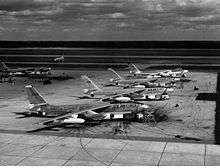
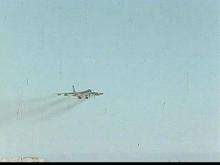
The USAF Strategic Air Command operated B-47 Stratojets (B-47s, EB-47s, RB-47s and YRB-47s) from 1951 through 1965.
When B-47s began to be delivered to the Air Force, most crews were excited about getting their hands on the hot new bomber, an aircraft whose performance was closer to that of jet fighters of the period than SAC's extant B-36 Peacemaker bomber. The B-47 was so fast that in the early days the aircraft set records with ease. The aircraft handled well in flight, with a fighter-like light touch to the controls. The large bubble canopy for the pilot and co-pilot enhanced the fighter-like feel of the aircraft with improved vision, but the design would also cause variations in internal temperatures for the three-man crew.
The three man crew consisted of the aircraft commander, copilot, and a navigator/bombardier or a crew chief. The B-47 was a maintenance "hog", so as a "valuable member of the ground crews, the crew chief was eligible for $50.00 per month flight pay if they flew the customary 4 hours a month required by regulations."[12]:44–45,136,156
It took the Air Force until 1953 to turn the B-47 into an operational aircraft. The aircraft was sluggish on takeoff and too fast on landings, a very unpleasant combination. If the pilot landed at the wrong angle, the B-47 would "porpoise", bouncing fore-and-aft. If the pilot did not lift off for another go-around, instability would quickly cause the bomber to skid onto one wing and cartwheel. Because the wings and surfaces were flexible and bent in flight, low altitude speed restrictions were necessary to ensure effective flight control.
Improved training led to a good safety record, and few crews felt the aircraft was unsafe or too demanding, but apparently there were some aircrews who had little affection for the B-47. Crew workload was high, with only three officer crew members to keep the B-47 flying right. Boeing's B-52 Stratofortress, in contrast, generally had six crewmen, five officers and one enlisted, with far more internal cabin space.
Training and problems
The B-47's reliability and serviceability were regarded as good. The only major problem was poor avionics reliability, normal in this environment given the vacuum tube technology at the time, and the need to place some equipment outside the pressurized crew compartment. Much work was done to improve avionics reliability, but they remained problematic throughout the B-47's operational life.
Starting in 1950, several models of the B-47 included a fuel tank inerting system, in which dry ice was sublimed into carbon dioxide vapor while the fuel pumps operated or while the in-flight refueling system was in use. The carbon dioxide was then pumped into the fuel tanks and the rest of the fuel system, ensuring that the amount of oxygen in the fuel system was low, reducing the probability of an explosion. Ten carbon dioxide tanks and heaters were involved. The system was implemented largely to reduce risks from static electricity discharges occurring during in-flight refueling.

Initial mission profiles included the loft bombing of nuclear weapons. As the training for this imposes repeated high stress on the aircraft, the airframe lifetime would have been severely limited by metal fatigue, and this maneuver was eliminated.
Prime years
An XB-47 was flown in the 1951 Operation Greenhouse nuclear weapons testing. This was followed by a B-47B being flown in the 1954 Operation Ivy and the 1955 Operation Castle. A B-47E was then flown in the 1956 Operation Redwing.[12]:98–109
"Reflex" missions proved the long-endurance (eighteen hours) and long range capability of the B-47 and aircrews. These were "simulated strike missions against the then Soviet enemy."[12]:110,163,194,199
Three B-47s flew cross country from March Air Force Base to the Philadelphia International Airport as participants in the 1955 Labor Day race. In the 1956 event, three B-47s participated in the G.E. Trophy race for Jet Bombers, flying from Kindley Field, Bermuda, to Oklahoma City. One of these set a course speed record of 601.187 MPH.[12]:126–131[26][27]
By 1956, the U.S. Air Force had 28 wings of B-47 bombers and five wings of RB-47 reconnaissance aircraft. The bombers were the first line of America's strategic nuclear deterrent, often operating from forward bases in the UK, Morocco, Spain, Alaska, Greenland and Guam. B-47s were often set up on "one-third" alert, with a third of the operational aircraft available sitting on hardstands or an alert ramp adjacent to the runway, loaded with fuel and nuclear weapons, crews on standby, ready to attack the USSR at short notice.
Crews were also trained to perform "Minimum Interval Take Offs (MITO)",[12]:36,162,193 with one bomber following the other into the air at intervals of as little as 15 seconds, to launch all bombers as fast as possible. MITO could be hazardous, as the bombers left wing tip vortices and general turbulence behind them, and with first generation turbojet engines with water-injection systems, they also created dense black smoke.[12]:180
The B-47 was the backbone of SAC into 1959, when the B-52 began to assume nuclear alert duties and the number of B-47 bomber wings started to be reduced. B-47 production ceased in 1957, though modifications and rebuilds continued after that.
Operational practice for B-47 bomber operations during this time went from high altitude bombing to low altitude strike, which was judged more likely to penetrate Soviet defenses. Bomber crews were trained in "pop-up" attacks, coming in at low level at 425 knots (787 km/h) and then climbing abruptly near the target before releasing a nuclear weapon.[12]:131–134,212
Later years
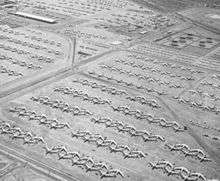

Stress and fatigue incurred in low-altitude operations led to a number of wing failures and crashes and an extensive refit program was begun in 1958 to strengthen the wing mountings. The program was known as "Milk Bottle", named after the big connecting pins that were replaced in the wing roots.
One of the more notable mishaps involving a B-47 occurred on 5 February 1958 near Savannah, Georgia, in the so-called 1958 Tybee Island B-47 crash. A B-47 based out of Homestead AFB, Florida, was engaged in a simulated combat exercise against an F-86 fighter. As was the practice at the time, the B-47 was carrying a single 7,600 lb (3,400 kg) Mark 15 nuclear bomb, without its core.[28] During this exercise, the F-86 collided with the B-47. The F-86 pilot ejected and the fighter crashed; the B-47 suffered substantial damage, including loss of power in one outboard jet engine. After three unsuccessful landing attempts at Hunter Air Force Base, the bomber pilot had to "safe" soft drop the Mark 15 weapon off the coast of Savannah, Georgia near Tybee Island. The bomb was jettisoned and the aircraft landed safely. An extensive nine-month search was mounted for the unarmed bomb, but proved futile.[29][30][31]
Final phaseout of B-47 bomber wings began in 1963, and the last bombers were out of service with SAC by 1966. The last USAF operational aircraft, WB-47Es assigned to the Air Weather Service, were withdrawn from use in September 1969. Shortly before, a B-47E number 53-2280 was used as a testbed for crucial early test of the newly developed fly-by-wire system.[32]
The U.S. Navy kept specialized EB-47E test aircraft bailed from USAF inventory in occasional use in support of the Fleet Electronic Warfare Systems Group (FEWSG) until December 1977 when they were replaced by government owned/contractor operated (GOCO) NKC-135 Stratotanker aircraft also loaned from USAF inventory.[33]
The final recorded flight of a B-47 was on 17 June 1986, when a B-47E was restored to flight-worthy condition for a one-time ferry flight. This aircraft was flown from Naval Air Weapons Station China Lake, California, to Castle Air Force Base, California, for static display at the Castle Air Museum where it still resides.[12]:217–219
Reconnaissance
The only B-47s to see anything that resembled combat were the aerial reconnaissance variants. The first overflight of Soviet territory with a B-47B, equipped "with special radar and photographic cameras installed in the bomb bay," took place on 15 October 1952, when one flying out of Alaska overflew Soviet airfields in Northeastern Siberia.[12]:90–97 RB-47s operated from almost every airfield that gave them access to the USSR, and they often probed Soviet airspace. On occasion, their pilots were caught in situations from which they escaped mostly through speed and evasion. At least five of these aircraft were fired on, and three were shot down. The RB-47s fired back with their tail turrets, although it is uncertain if they scored any kills. Nonetheless, these were the only shots fired in anger by any B-47.
On 8 May 1954, after a top secret reconnaissance mission in the Kola Peninsula, a 4th Air Division 91 Strategic Reconnaissance Wing RB-47E reconnaissance aircraft, with Harold Austin at the controls, flew over the Soviet Union. The RB-47E was flying at high altitude, out of reach of MiG-15s, but unknown to USAF intelligence some MiG-17s had been stationed in the area that were able to intercept the intruder. The RB-47E was chased by several Soviet MiG-17 fighters attempting to destroy the aircraft with their guns over Soviet and Finnish airspace. Although sustaining damage, the RB-47E managed to escape over Sweden back to its home base at RAF Fairford, Gloucestershire. Its top speed and combat radius superiority to the Soviet fighter jets were the deciding factors. The mission marked the first time a jet aircraft equipped with modern aerial photography equipment, K-17 and K-38 cameras, was used for American military reconnaissance over the Soviet Union. The incident was kept secret by all parties.[12]:85–89
Other interceptions resulted in losses. An RB-47 flying out of Alaska was scouting out the Kamchatka Peninsula on 17 April 1955, when it was intercepted by Soviet MiG-15s in international airspace. The RB-47 and its crew disappeared. Between 21 March and 10 May 1956, 16 RB-47Es and five RB-47Hs operating from Thule performed overflights the length of Siberia 156 times under Project HOMERUN. The Soviets filed an angry complaint with the U.S. government, which attributed the overflights to "navigational difficulties". MiGs intercepted RB-47s on three separate occasions in the fall of 1958: over the Black Sea on 31 October, over the Baltic on 7 November, and over the Sea of Japan on 17 November.
On 1 July 1960, a PVO Strany MiG-19 shot down an RB-47H (AF Serial No. 53-4281) reconnaissance aircraft in the international airspace over the Barents Sea[34] with four of the crew being killed and two captured by the Soviets, but released in 1961. The co-pilot reported that the MiG-19 jammed ("whited-out") his MD-4 FCS scope (the radar which aimed the tail guns), rendering the RB-47H defenseless.[35] The last known confrontation between MiGs and RB-47s took place on 28 April 1965, when an ERB-47H was intercepted by two North Korean MiG-17s over the Sea of Japan. The MiGs scored hits on the aircraft, but the ERB-47H managed to make it back to Yokota Air Base in Japan with three engines out.[12]:208–211
While a few of these aircraft performed special duties during the Vietnam War, such as relaying ELINT data from drones, they were eventually replaced by much more efficient and capable Boeing RC-135 platforms. The last RB-47H was retired on 29 December 1967.
The final 15 RB-47s, built beginning in December 1955, were fitted with additional equipment, including the AN/APD "side looking airborne radar" (SLAR) system, and gear to sample the air for fallout from nuclear tests. These models were given the new designation RB-47K. These were generally used for weather reconnaissance missions, carrying a load of eight "dropsonde" weather sensors that were released at various checkpoints along the aircraft's flight path. Data radioed back from the dropsondes was logged using equipment operated by the navigator. The RB-47Ks stayed in service until 1963.
Variants
- Section source: Baugher.[36]
- XB-47
- Two prototype aircraft. Two built as Model 450-1-1 and 450-2-2 respectively,(46-065 and 46-066); powered by six Allison J-35-GE-7 turbojet engines for the first flights. The second, and subsequent aircraft were built with the specified General Electric J-47-GE-3 engines, which were retrofitted to the first XB-47.[37]
- B-47A
 B-47A Stratojet, described by the press as the "fastest bomber in the world" flies near the Boeing production plant in Wichita, Kansas, 11 August 1950
B-47A Stratojet, described by the press as the "fastest bomber in the world" flies near the Boeing production plant in Wichita, Kansas, 11 August 1950
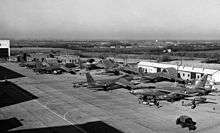
The first 10 aircraft were designated "B-47A", and were strictly evaluation aircraft. The first was delivered in December 1950. The configuration of the B-47As was close to that of the initial XB-47 prototypes. They were fitted with J47-GE-11 turbojets, offering the same 5,200 lbf (23 kN) thrust as the earlier J47-GE-3, and they also featured the built-in rocket-assisted-take-off (RATO) bottles.[37]
- Four of the B-47As were fitted with the K-2 bombing and navigation system (BNS), with an HD-21D autopilot, an analog computer, APS-23 radar, and a Y-4 or Y-4A bombsight. Two were fitted with the tail turret mounting two 20mm cannons; one of them using an Emerson A-2 fire control system (FCS), another an early version of the General Electric A-5 FCS. The eight other B-47As had no defensive armament.
- The B-47As were fitted with ejection seats. The pilot and copilot ejected upward, while the navigator had a downward ejection seat built by Stanley Aviation.[38] Minimum safe ejection altitude was about 500 ft (150 m). In the 1950s, there were no high-tech "dummies" to test ejection seats and live people had to be used. A number of volunteers were injured in the development of the B-47s downward ejection seat. The first person to successfully test the B-47s downward ejection seat was on 7 October 1953, by USAF Colonel Arthur M. Henderson who was ejected over Chocktawhatchee Bay, near Eglin Air Force Base, Florida, for safety reasons; in a later ejection, this proved wise when during one test, a volunteer dislocated his shoulder.[39]
- While the XB-47s had been built by Boeing at their Seattle, Washington, plant, the B-47As and all following Boeing B-47 production, were built at a government-owned factory in Wichita, Kansas, where the company had built B-29s in the past. The switch was made because the Seattle plant was burdened with Boeing KC-97 Stratofreighter production and other urgent programs.
- Most of the B-47As were phased out of service by early 1952, though one did perform flight tests for NACA for a few more years. While the Air Force put the B-47As through their paces, the Cold War was rising to full force, with a hot war intensifying in Korea. The USAF's Strategic Air Command (SAC) needed an effective nuclear deterrent to keep the Soviet Union in line, and the Stratojet was an excellent tool for the task, and Boeing was already working on production bombers.
- B-47B
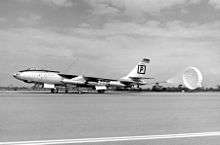 Boeing B-47B (51-2212) of the 306th Bomb Wing (Medium) at MacDill AFB, Florida landing with drag chute
Boeing B-47B (51-2212) of the 306th Bomb Wing (Medium) at MacDill AFB, Florida landing with drag chute
Following a series of preliminary contracts for production B-47s, in November 1949, even before the first flight of the B-47A, the Air Force had ordered 87 B-47Bs, the first operational variant of the type. The first B-47B flew on 26 April 1951. A total of 399 were built, including eight that were assembled by Lockheed and 10 that were assembled by Douglas, using Boeing-built parts.
- The USAF was impatient to get their hands on as many B-47s as they could as quickly as possible, and signed up Lockheed and Douglas for the additional production. Lockheed-built aircraft were designated by a "-LM (Lockheed Marietta)" suffix and Douglas-built aircraft given a "-DT (Douglas Tulsa)" suffix. Boeing production was designated by a "-BW (Boeing Wichita)" suffix, except for the Seattle-built XB-47s and B-47As, which had a "-BO" suffix.
- The initial batch of 87 B-47Bs featured the same J47-GE-11 engines as the B-47As, but all subsequent production featured substantially uprated J47-GE-23 turbojets with 5,800 lbf (26 kN) thrust. Early production aircraft were retrofitted with the improved engines. They all featured the built-in RATO system used on the XB-47 and B-47A.
- All featured full combat systems. Early production retained the K-2 BNS installed on some of the B-47As, but most production featured the K-4A BNS, which featured an AN/APS-54 warning radar and an AN/APT-5 electronic countermeasures (ECM) system.
- The K-4A used a periscopic bombsight fitted into the tip of the nose of the aircraft, with the transparent plexiglas nose cone of the XB-47 and B-47A replaced by a metal nose cone. There were four small windows on the left side of the nose and two on the right. Another visible change from the earlier models was that the B-47B had a vertical tailplane with a squared-off top, rather than a rounded top as with its predecessors.
- The bomb bay of the B-47B was shorter than that of the XB-47 and B-47A, since nuclear weapons had shrunk in the interim. However, the B-47B could carry a much larger bombload, of up to 18,000 lb (8,200 kg). All B-47Bs carried the tail turret with twin 20 mm (0.79 in) guns and the B-4 radar-guided FCS (Fire Control System). The B-4 FCS proved troublesome, and in some B-47Bs, it was replaced with an N-6 optical sight. The copilot could swivel his seat around to face backward and sight the guns directly.
- In practice, even the enormous fuel capacity of the B-47 was still not enough to give it the range the Air Force wanted, and in fact there had been substantial prejudice against the type among the senior Air Force leadership because of the limited range of the initial design. Solution of this problem was a high priority, and so an "in-flight refueling (IFR)" receptacle was fitted in the right side of the nose for "flying-boom"-style refueling from KB-50 and KC-97 aircraft. This was the main reason for the deletion of the plexiglas nose cone for the bombardier navigator.
- The B-47B was also fitted with a pair of jettisonable external tanks, carried between the inboard and outboard engine assemblies. These external drop tanks were very large, with a capacity of 1,780 US gal (6,700 l).
- The B-47B suffered a considerable gain in weight compared to the B-47A, and so as a weight-reduction measure the ejection seats were deleted, and a windbreak panel was fitted to the aircraft's main door to make escapes easier. Some sources also claim that a fatal ejection-seat accident in a B-47A contributed to this decision. Whatever the case, this was not a very popular measure with crews, as getting out of the aircraft even at altitude was troublesome. In 1956 all the surviving B-47Bs were modified to the same standard as the B-47Es, and ejection seats were added.
- Between 1955 and 1956 Boeing at Wichita modified the surviving B-47Bs from line numbers 235 to 399 to the same standard as the B-47E under program High Noon; this included fitting ejections seats, and enhancement of systems. This was followed by the Ebb Tide program that modified the early line numbers from 1 to 234; this included 66 aircraft from the 135 to 234 batch to the same standard as the High Noon aircraft; another 30 in the same range would have addition modification as drone directors DB-47Bs, and the 1 to 134 range which would have the same High Noon modification, but without some of the non-combat changes. Following the modification programs the aircraft are sometimes referred to as the B-47B-II.
- YRB-47B
- The U.S. Air Force had considered building a specialized RB-47B reconnaissance variant to complement the B-47B bomber version, but as it turned out schedule slips and the like ensured that the RB-47E was the first production reconnaissance variant. As an interim measure before the RB-47E went into service, 91 B-47B bombers were fitted with a heated pod with eight cameras that were stowed in the forward bomb bay; these aircraft were designated YRB-47Bs. They were capable of daylight reconnaissance only, and when the RB-47Es were delivered, they returned to the bomber role.
- TB-47B
- A total of 66 B-47Bs which were survivors of the first batch of 87 non-combat B-47Bs were re-designated TB-47B in 1953, to alleviate logistics problems due to different engines and systems. Most of them were used as trainers and some were modified for Air Training Command by Douglas at Tulsa under the Field Goal program; the simple modification added a fourth seat for an instructor and removed the tail turret. These aircraft were upgraded to the latest B-47E standard in 1956 under the Ebb Tide program and were joined by 41 more early build aircraft, also designated TB-47B. These aircraft provided valuable crew training through most of the 1950s.
- MB47-B
- With the introduction of the hydrogen bomb, the USAF contemplated the conversion of a few B-47Bs into MB-47B drones, which would essentially be huge cruise missiles carrying H-bombs. The program was known as "Brass Ring". Closer examination of the scheme showed that it was impractical, and Brass Ring was canceled on the appropriate date of 1 April 1953.
- YDB-47B
- There were various flight tests through the 1950s for using the B-47B as a launcher for the big 31 ft (9.5 m) liquid-fueled GAM-63 Rascal missile, and one B-47B was modified to become a YDB-47B Rascal launcher. However, the Rascal program was politically problematic, and never became operational, though a total of 74 B-47Bs were modified into DB-74B Rascal launchers before the program was canceled.
- WB-47B
- In 1956, a single B-47B was converted into a WB-47B weather reconnaissance aircraft and operated by the Military Air Transportation Service (MATS), making it one of the few B-47s that wasn't operated by SAC. This aircraft remained in service with the Air Weather Service of the Military Airlift Command (MAC) until the mid-1960s.
- KB-47B
- In 1953, two B-47Bs were modified for testing the probe-and-drogue refueling system. The tanker was given the designation KB-47G and was known as "Maw" by flightcrews, and was fitted with a British-built tanker kit. The refueling test aircraft was given the designation YB-47F and was known as "Paw", though other aircraft (including the YB-52 prototype) were also used as refueling targets. The program was cancelled in 1954; it turned out that the KB-47G simply could not carry enough fuel to make it a useful tanker. The idea of fielding B-47 tanker conversions came up again a few years later, but the economics did not make sense, and the notion was finally put to rest for good in 1957. Around the same time the KB-47 tanker prototypes were being tested, Boeing tested its aerial refueling equipment using its Dash 80, which evolved into the KC-135 Stratotanker, which has greater fuel capacity.
- Canadair CL-52
- One of the most unusual B-47B conversions was the Canadair CL-52 which was a B-47B loaned in 1956 to the Royal Canadian Air Force to test the new, powerful Orenda Iroquois turbojet (rated at 19,250 lbf (85.6 kN) dry, 25,000 lbf (110 kN) afterburning) for the Avro Canada CF-105 Arrow interceptor. Canadair Aircraft, the sub-contractor, attached the Iroquois engine to the right side of the rear fuselage near the tail; due to the large exterior diameter of the engine, no other location was feasible.[40] Flying the CL-52 was reportedly a nightmare. After the Arrow project was canceled in early 1959, the B-47B/CL-52, with about 35 hours of engine flight tests to its credit, was returned to the U.S. Some sources claimed it was bent out of shape by the tests, but in any case, it was subsequently scrapped. The CL-52 was the only B-47 to be used by any foreign service.
- YB-47C / RB-47C / B-47Z / B-56

- A four-engined variant of the B-47, the YB-47C, was proposed by Boeing in 1950 to be powered by four Allison J35-A-23 turbojet engines, providing 10,090 lbf (44.9 kN) thrust each, in place of the six GEs J47s. The J35 turbojet engine was being developed during the late 1940s, and it was provisionally rated at 9700 pounds (with afterburner) or 8500 pounds thrust without AB. Thus 4 * 8500 = 34,000 pounds using that engine, as compared to 6 * 5200 = 31,200 pounds in the production B-47. So the conversion would be lighter, simpler and more powerful.[41] J71-A-5
- A contract was signed with Boeing in January 1950, calling for rework of one B-47B aircraft. The date for first flight was projected as April 1951.[42]
- A combination of delays and less-than-expected performance of the J35 led to the consideration of other engines. The Allison J71 was proposed,[41] however problems with this engine meant that this was not feasible for the by-then redesignated B-56A. The Pratt & Whitney J57, eventually rated at 17,000 pounds thrust, was also considered, but that engine was still in development, and the Boeing B-52 Stratofortress, which was being concurrently developed (first flight was April 1952), had priority for this engine.[37]
- The B-56 was cancelled in December 1952 before conversion of the prototype was started.[37] The donor fuselage that would have been the basis of the XB-56 prototype was then used as a ground instructional airframe.
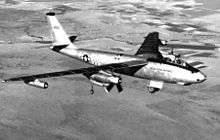
- XB-47D
- Beginning in 1951, two XB-47Ds were modified from B-47Bs as purely experimental platforms, with a big Wright YT49-W-1 turboprop engine spinning a huge four-paddle prop, replacing each of the inboard two-jet pods.[12]:38–42[43] Difficulties with engine development delayed first flight of the XB-47D until 26 August 1955. The aircraft's performance was comparable to that of a conventional B-47, and its reversible propellers shortened the landing roll, but the USAF did not follow up the idea.
- B-47E
- The designations B-47C and B-47D were applied to special variants that never went into production (described later), and so the next production version of the B-47 was the definitive B-47E.
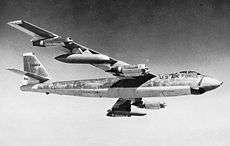
- The first B-47E flew on 30 January 1953. Four "blocks" or "phases" of the B-47E were built, each incorporating refinements on the previous block, and also sometimes featuring production changes within a block. Older blocks were generally brought up to the specifications of later blocks as they were introduced. The B-47 also incorporated the production model with the radar controlled rear tail turret.
- Early production "B-47E-Is" also known featured J47-GE-25 turbojets with 5,970 lbf (26.6 kN) thrust, but they were quickly changed to J47-GE-25A engines, which featured a significant improvement in the form of water-methanol injection. This was a scheme in which a water-methanol mix was dumped into the engines at takeoff, increasing mass flow and so temporarily kicking the thrust up to 7,200 lbf (32 kN). Methanol was apparently added to the water as an anti-freezing agent. The engines left a trail of black smoke behind them when water-methanol injection was on.
- Jet-Assisted Take Off or JATO modifications were performed on early B-47E-Is. They had the 18 built-in JATO bottles, and were quickly exchanged for an external, jettisonable "split V" or "horse collar" rack fitted under the rear fuselage. The rack carried 33 JATO bottles, in three rows of 11 bottles.[12]:31,36–37,191,195 The built-in JATO system was eliminated because of worries about having the JATO bottles so close to full fuel tanks, and in any case once the rocket bottles were exhausted they were just dead weight. The racks were expendable, and were dropped over specific range areas after takeoff.

- The internal fuel capacity of initial production B-47Es was cut to 14,627 US gal (55,370 l) as a weight-saving measure. This was considered acceptable because of the use of the big external tanks and the fact that the USAF had refined mid-air refueling to the point where it could be relied upon as a standard practice.
- One welcome change in the B-47E relative to the B-47B was the return of the ejection seats, the Air Force senior leadership having reconsidered the earlier decision to delete them. In addition, the twin .50 in guns (12.7 mm) in the tail turret were replaced with twin 20 mm (0.79 in) cannon to provide more firepower, backed up by an A-5 FCS in early production and an MD-4 FCS in later production.[44]
- A final change in the B-47E was that most of the windows in the nose were deleted, with only one left on each side. However, many pictures of B-47Es show them with the full set of windows used on the B-47B. Whether the number of windows varied through B-47E production, or whether these were B-47Bs updated to B-47E specification, is unclear.
- The B-47E-II featured only minor changes from late production B-47E-Is. The B-47E-III featured an ECM suite, consisting of a radar jammer in a bulge under the fuselage plus a chaff dispenser, as well as improved electrical alternators.
- The B-47E-IV was a much more substantial update, featuring stronger landing gear, airframe reinforcement, greater fuel capacity, and a bombload uprated to 25,000 lb (11,300 kg), though the bomb bay was once again shortened because of the introduction of more compact nuclear weapons.
- Another improvement was the introduction of the MA-7A BNS, a major step up from its predecessors. The MA-7A included the AN/APS-64 radar, with a range as long as 240 mi (390 km). The AN/APS-64 could be used as a long range "identification friend or foe (IFF) transponder" interrogator to allow a B-47E-IV to find a tanker or other B-47, or it could be used as a high-resolution ground-targeting radar. The B-47E-IV retained the optical bombsight, though this was rarely used.
- A total of 1,341 B-47Es were produced. A total of 691 were built by Boeing, 386 were built by Lockheed, and 264 were built by Douglas. Most B-47Bs were rebuilt up to B-47E standards. They were given the designation of B-47B-II, though it appears that in practice they were simply called B-47Es.

- TEE TOWN B-47E
- In 1955, 100 B-47E-Is were modified to carry two removable external pods, one mounted on either side of the bomb bay, with each pod containing four AN/ALT-6B jammers. The pods were known as "Tee Town pods" (for Topeka, Kansas, location of Forbes AFB) and so these aircraft were known as "Tee Town B-47s". They retained their normal bombing capability.
- EB-47E
- The Tee Town B-47s then led to a specialized ECM conversion of the B-47E, which was given the designation EB-47E. The initial EB-47 conversion featured a set of 16 jammers in a removable cradle stored in the bomb bay, plus radar warning receivers and chaff dispensers. These were known as "Phase IV" or "Blue Cradle" EB-47Es. The more advanced "Phase V" EB-47E featured a pressurized module that was stowed in the bomb bay, with 13 jammers under control of two electronic warfare officers (EWOs), also known as "Crows" or "Ravens"[12]:146,164–165,182,192,208–211,214 (both being black birds, it was a reference to "black ops", meaning classified operations). While the Phase IV jammer system was "broadband", blanketing a wide range of frequencies in hopes of jamming radars operating somewhere within that range, the Phase V jammer system could be selectively tuned to specific radar frequencies by the Crows, permitting much higher jammer power on the frequencies that did the most good. A radar jammer tends to announce its presence and location by the radio signals it emits, and EB-47E crews were perfectly aware that they were unlikely to return from an operational mission into the USSR. If they could cover for B-47 bombers, however, it would be worth the sacrifice. About 40 B-47Es were converted to EB-47Es that could not carry bombs, but did retain the tail turret.
- B-47E 52-0410 and 52-0412 were converted to EB-47Es in the mid-1960s for service with U.S. Navy's Fleet Electronic Warfare Support Group (FEWSG). Considered to be on indefinite loan from USAF, these aircraft were unlike the USAF EB-47Es, with some of their ECM gear fitted into pods carried on the external fuel tank pylons. They were used for tests of naval ECM systems and as "electronic aggressors" in naval and joint exercises. These two aircraft were the last B-47s in operational service, and 52-0410 performed the very last operational flight of a B-47 on 20 December 1977, when it was flown to Pease AFB, NH and put on display at the main gate. Following the closure/realignment of Pease AFB in 1991 and its conversion to Pease International Tradeport and Pease ANGB, this aircraft was disassembled and trucked to Ellsworth AFB, SD where it donated its nose and engines to RB-47H 53-4299, which is in the National Museum of the United States Air Force at Wright-Patterson AFB in Dayton, OH.
- EB-47E(TT)
- Three B-47Es were converted to the highly specialized EB-47E(TT) "Tell Two" configuration to be used for "telemetry intelligence", picking up radio signals from Soviet missile tests and space launches. The Tell Two was the precursor to the RC-135S Rivet Ball and Cobra Ball. The EB-47E(TT)s featured a "Crow capsule" in the bomb bay loaded with the appropriate gear and two ECM operators, and also featured odd and distinctive antennas just below each side of the cockpit. All three of these aircraft were operated out of Turkey, and stayed in service until 1967. The antennas on the nose of the aircraft attracted a good deal of attention from base personnel, and crews made up imaginative stories about them, for example claiming they were part of a "return to fighter (RTF)" defensive system that would cause Soviet air-to-air missiles to loop back and shoot down their own launch fighters. In reality, they were specialized receiver antennas used for intercepting telemetry signals from Soviet space and missile launches.
- ETB-47E
- As with the B-47B, a few B-47Es were converted to trainers, with a fourth seat for an instructor, and given the designation ETB-47E. These aircraft were used to replace TB-47Bs that had "got too long in the tooth," and served into the early 1960s.
- DB-47E / YDB-47E
- Two B-47Es were converted to YDB-47Es to support the GAM-63 RASCAL stand-off missile program, and two more B-47Es were converted to DB-47Es in preparation for the operational introduction of the missile before the program was axed. These two DB-47Es were later used as drone controller aircraft.
- JB-47E
- Several B-47Es were assigned to other specialized test duties and given the blanket designation of JB-47E. One was used in the late 1960s to test "fly by wire" control system concepts.
- JTB-47E
- Two B-47Es were also used for secret flight experiments in the early 1960s and given the designation JTB-47E, and a third, even more mysterious modified B-47E was given the designation JRB-47E. They appear to have been test platforms for ECM systems.
- NB-47E
- Finally, a B-47E was loaned to the U.S. Navy to help test the GE TF34-2 turbofan for the Lockheed S-3 Viking carrier-based antisubmarine warfare aircraft. This B-47E was given the designation NB-47E and performed test flights from 1969 through 1975.
- QB-47E
- A total of 14 RB-47Es were converted to QB-47E target drones in 1959 and 1960. These aircraft were radio-controlled, and included such interesting features as self-destruct charges and arresting gear to assist in landings. They also carried pods mounted on the external tank pylons to help in scoring weapons tests. Apparently most of the missiles fired on them were directed for a near-miss, but the QB-47Es were nonetheless eventually whittled down to two survivors that were retired in the early 1970s.
- RB-47E
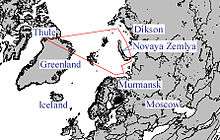 A typical reconnaissance route from Thule AB (Greenland) to Soviet Union flown by RB-47H crews
A typical reconnaissance route from Thule AB (Greenland) to Soviet Union flown by RB-47H crews- The B-47E was also the basis for a number of important long-range reconnaissance variants. The only B-47s to see anything that resembled combat were these reconnaissance variants. They operated from almost every airfield that gave them access to the USSR, and often probed Soviet airspace.
- Boeing-Wichita built 240 RB-47E reconnaissance variants, similar to the B-47E but with a nose stretched by 34 in (0.86 m), giving them an arguably more elegant appearance than the bomber variants of the B-47. The long nose was used to stow up to 11 cameras, which could include:
- An O-15 radar camera for low-altitude work.
- A forward oblique camera for low-altitude work.
- A K-17 trimetrogon (three-angle) camera for panoramic shots.
- K-36 telescopic cameras.
- The RB-47E could carry photoflash flares for night reconnaissance. Although the RB-47E could be refueled in flight, its fuel capacity was increased, to a total of 18,400 US gal (70,000 l). The navigator controlled the cameras, becoming a "navigator-photographer" instead of a "navigator-bombardier".
- WB-47E
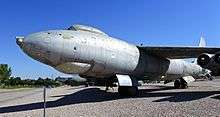
- Following the single WB-47B weather reconnaissance conversion, in the early 1960s, 34 B-47Es were converted by Lockheed into WB-47Es for weather reconnaissance to replace 44 WB-50D Superfortresses that had experienced an alarming number of fatal crashes between 1956 and 1960. These aircraft were stripped of combat gear, including the tail turret. They were fitted with cameras in the nose to take pictures of cloud formations, and carried a special meteorological instrument pod in the bomb bay. Initially assigned to the Air Weather Service of the Military Air Transport Service (MATS), they became part of the Military Airlift Command (MAC) when that organization was established. The WB-47Es were abruptly grounded in September 1969 and retired the next month, the last B-47s in operational USAF service.
- The 53d Weather Reconnaissance Squadron, of the 9th Weather Reconnaissance Wing, operated WB-47Es from Hunter Air Force Base and Ramey Air Force Base. These assets were transferred to the 57th Weather Reconnaissance Squadron for Operation Arc Light, operating from Clark Air Base.[12]:177–179
- RB-47H/ERB-47H
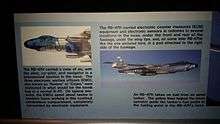
- A total of 32 RB-47H models were built for the electronic intelligence (ELINT) mission, as well as three more specialized "ERB-47Hs". These aircraft featured distinctive blunt, rounded nose and sported blisters and pods for intelligence-gathering antennas and gear. They were designed to probe adversary defenses and then collect data on radar and defense communications signals.
- The bomb bay was replaced by a pressurized compartment, which accommodated "Crows", or Electronic Warfare Officers. There were three Crows on board the RB-47H, but only two on the ERB-47H. A distinctive bulged radome fairing replaced the bomb bay doors. The RB-47H / ERB-47H retained the tail turret, and were also fitted with jammers and chaff dispensers. The only easily recognizable difference in appearance between the RB-47H and ERB-47H was that the ERB-47H had a small but distinctive antenna fairing under the rounded nose.
- The first RB-47H was delivered in August 1955 to Forbes AFB, Kansas. The ELINT B-47s proved so valuable that they were put through a "Mod 44" or "Silver King" update program in 1961 to provide them with updated electronics systems. Silver King aircraft could be easily recognized by a large teardrop pod for ELINT antennas attached to a pylon, mounted under the belly and offset to one side of the aircraft, as well as a pylon-style antenna attached under each wing beyond the outboard engine. It is unclear if all RB-47Hs and ERB-47Hs were updated to the Silver King specification.
- The RB-47H and ERB-47H were highly capable aircraft, but the EWO compartment was not only cramped with sitting room only, but also had both poor noise insulation and climate control. This made 12-hour missions very uncomfortable and tiring, and some sources say that the Crows even had to deal with fuel leaks on occasion. Successful ejection downward (cutting through the belly radome) was impossible on-or-near the ground. Crows sat bobsled-like on the pilot compartment access floor for takeoff and landing; having to crawl encumbered with Arctic clothing with parachute to-from their compartment along an unpressurized maintenance shelf during temporary level-off at 10,000 ft (3,000 m).
- Operations of the RB-47H and ERB-47H were often classified Top Secret,[12]:179–181 with the ten-hour missions generally flown at night. When crews were asked what they were doing, they always answered that such information was classified. On inquiries on what the blunt black nose was for, they would sometimes reply that it was a bumper, used in in-flight refueling in case they nosed into the tanker. This reply was often believed.
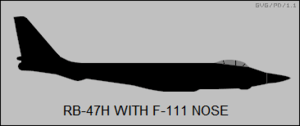
- The final RB-47H to be retired from service, 53-4296, was later pulled out of the "boneyard" and used for tests of avionics for the General Dynamics FB-111. This RB-47H was fitted with an F-111-style nose and flew into the early 1970s. It was not given any special designation. It is now on display at the Air Force Armament Museum at Eglin Air Force Base, fitted with a bomber nose.
- YB-47J
- A single B-47E was modified to test the MA-2 BNS for the B-52, and given the designation YB-47J. Other B-47Es were also apparently used in the MA-2 tests, but not given a special designation.
- RB-47K
- The RB-47K was a photo and weather reconnaissance variant based on the RB-47E; they were generally used for weather reconnaissance missions, carrying a load of eight dropsonde weather sensors that were released at various checkpoints along the aircraft's flight path. Data radioed back from the dropsondes was logged using equipment operated by the navigator. Fifteen RB-47Ks were built and the variant stayed in service until 1963.
- EB-47L
- Between 1961 and 1963, 36 B-47Es were modified to carry a communications relay system. These aircraft were given the new designation of EB-47L, and were used to support U.S. flying command post aircraft in case of a nuclear attack on the U.S. The EB-47Ls only remained in service for a few years, as improved communications technologies quickly made them redundant by 1965.
Operators
- Royal Canadian Air Force – 1 B-47B loaned to Canada and converted by Canadair with the designation CL-52 to test the CF-105 Avro Arrow's Orenda engines in 1956; returned to USAF's Davis-Monthan AFB and scrapped (1957)[45]
Surviving aircraft

About 25 surviving airframes exist in museum collections worldwide.
Accidents and incidents
On 10 March 1956, four B-47 Stratojets left MacDill Air Force Base in Florida for a non-stop flight to Ben Guerir Air Base in Morocco. Their first aerial refueling was completed without incident. After descending through clouds to begin their second refueling, over the Mediterranean Sea at 14,000 ft, one of the four aircraft failed to make contact with the tanker. Neither the aircraft nor its personnel were ever found.
On 28 March 1956, a B-47 Stratojet exploded over East Wichita as thousands watched. It crashed four miles northeast of the city, killing its crew of three. The office of information services at McConnell Air Force Base said the explosion occurred after takeoff, probably at about 2,000 feet altitude. Wreckage was strewn along the countryside for several miles as the wings sheared off and the fuselage tumbled to earth.[46]
On 27 July 1956, a B-47 Stratojet of the 307th Bombardment Wing crashed at RAF Lakenheath killing its crew and causing a near nuclear accident when the aircraft hit a storage igloo containing three MK-6 nuclear weapons. Although the bombs involved in the accident did not have their fissile cores installed, each of them carried about 8,000 pounds of high explosives as part of their trigger mechanism. The crash and ensuing fire did not ignite the high explosives and no detonation occurred.[47]
In November 1956, B-47E Stratojet 51-2421 of the 96th Bombardment Wing, flying from Altus AFB crashed on a farm near Hobart, OK following engine problems.[48] The aircraft impacted the ground 320 yards west of a barn owned by Charles C. Harris, skidded into it and exploded. Four officers were lost in the incident.[49]
On 9 October 1957, B-47 Stratojet 51-2177A, of the 447th Bomb Squadron, 321st Bomb Wing at Pinecastle Air Force Base suffered wing failure and crashed northwest of Orlando, Florida and west of Winter Park, Florida while taking part in a practice demonstration during the annual Strategic Air Command Bombing Navigation and Reconnaissance Competition at Pinecastle AFB. The wing commander, Colonel Michael Norman Wright McCoy, was killed in the crash. Pinecastle Air Force Base was later renamed McCoy Air Force Base in his honor.
On 5 February 1958, a B-47 Stratojet was involved in a mid-air collision with an F-86 fighter over Georgia, known as 1958 Tybee Island mid-air collision.[12]:77–80
On 13 March 1958, a B-47 Stratojet exploded over southeast Tulsa, Oklahoma, killing one crewman and raining debris over at least 8 square miles. Two of the three men on the six-engine bomber on a training mission from McConnell Air Force Base in Wichita, Kansas, parachuted to safety. The third was trapped in the nose of the plane and died. Thousands of people on the ground heard the explosion and witnessed the plane's disintegration and fall.[50]
On 4 April 1959, a B-47 Stratojet, number 52-0320, crashed in the Santa Rita mountains, just south of Tucson, Arizona. At the time—1:20AM—the plane was attempting to land at the adjacent Davis-Monthan Air Force Base. All three individuals on board at the time were killed. Crash investigators indicated that a faulty altimeter was a contributing factor in causing the accident.[51]
On 30 December 1959, a B-47B Stratojet crashed at Torrejón Air Base, Spain, one minute after takeoff. The four crew members were killed in the crash.[52]
On 31 March 1960, a Boeing B-47E (sn 52-1414), suffered an inflight explosion and structural failure over the city of Little Rock, Arkansas. Three of the four crewmembers and two civilians on the ground lost their lives. The aircraft was based with the 384th Bomb Wing (SAC), 545th Bombardment Squadron, Little Rock AFB.
On 24 February 1961, a B-47 Stratojet crashed 10 miles southwest of Hurley, Wisconsin. The crash at about 10:00 P.M. occurred while the plane was on a practice bombing mission from the 40th Bomb Wing at Forbes Air Force Base, Topeka, Kansas and took the lives of four men. One of the plane's jet engines was found 600 yards from the point of impact, indicating it was dislodged from the plane before it crashed in flames.[53]
On 2 May 1961, Two of four crew members survived the crash of a B-47 Stratojet eight miles southwest of Hurley, Wisconsin and only a few miles from the scene of another Stratojet crash on 24 February 1961. Indications were that the bomber was diving at a steep angle when the crash occurred.[54]
In January 1962, a B-47 based at Plattsburgh Air Force Base on a training mission crashed into the side of Wright Peak in the High Peaks in the Adirondacks of New York. All four crew members were killed. Wreckage from the plane can still be found at the summit of the mountain. A landing gear strut and a piece of the engine include some of the wreckage. The airplane had veered about 30 miles east due to inclement weather.[55]
On July 23, 1962, a B-47 based at Dyess Air Force Base near Abilene, Texas, departed around 6:30 that night for a routine training mission through Montana. After flying near Dillon, MT and crossing into Paradise Valley, the plane crashed into the side of Emigrant Peak and exploded while executing a turn toward the northwest. All four crewmembers were killed.[56]
On 20 February 1963, a B-47 Stratojet, of the 98th Bomb Wing based at Lincoln AFB, Nebraska, crashed in Bashaw Township, approximately 3 miles north of the town of Comfrey, Minnesota. All four crew members, on board, were killed. The crew had just completed a low-altitude, simulated bombing run near the town of Heron Lake, Minnesota, when the jet's sixth engine failed causing the jet to crash in a field resulting in a 25-foot deep by 50-foot wide crater.[57][58][59]
On 20 August 1963, a QB-47 veered off course on its landing approach at Eglin Air Force Base and crash landed on a stretch of road that ran parallel to the runway. The QB-47 that crashed was used for Bomarc Missile Program tests, which normally operated from Eglin Air Force Base Auxiliary Field Number Three (Duke Field), approximately 15 miles (24 km) north of the main base. Two cars were crushed by the crash landing, killing two occupants who both worked for the Honeywell Corporation at the time, a firm which had just completed flight tests on an inertia guidance sub-system for the Boeing X-20 Dyna-Soar project at the base, and injuring a third. Both vehicles were destroyed by fire.[60]
Specifications (B-47E)

Data from Quest for Performance.[61]
General characteristics
- Crew: 3
- Length: 107 ft 1 in (32.65 m)
- Wingspan: 116 ft 0 in (35.37 m)
- Height: 28 ft 0 in (8.54 m)
- Wing area: 1,428 ft² (132.7 m²)
- Airfoil: NACA 64A(0.225)12 mod root and tip
- Empty weight: 79,074 lb (35,867 kg)
- Loaded weight: 133,030 lb (60,340 kg)
- Max. takeoff weight: 230,000 lb (100,000 kg)
- Powerplant: 6 × General Electric J47-GE-25 turbojets, 7,200 lbf (32 kN) each
- Zero-lift drag coefficient: 0.0148 (estimated)
- Drag area: 21.13 ft² (1.96 m²)
- Aspect ratio: 9.42
Performance
- Maximum speed: 607 mph (528 kn, 977 km/h)
- Cruise speed: 557 mph (484 kn, 896 km/h)
- Combat radius: 2,013 mi (1,749 nmi, 3,240 km) with 20,000 lb (9,000 kg) bombload
- Ferry range: 4,647 mi (4,037 nmi, 7,478 km)
- Service ceiling: 33,100 ft (10,100 m)
- Rate of climb: 4,660 ft/min (23.7 m/s)
- Wing loading: 93.16 lb/ft² (454.8 kg/m²)
- Thrust/weight: 0.22
- Lift-to-drag ratio: 20.0 (estimated)
Armament
- Guns: 2× 20 mm (0.787 in) M24A1 autocannons in a remote controlled tail turret with AN/APG-39 Gun-laying radar[62]
- Bombs: 25,000 lb (11,000 kg) of ordnance, including:
- 2 × Mk15 nuclear bombs (3.8 megaton yield each), or
- 1 × B41 nuclear bomb (25 megaton yield), or
- 1 × B53 nuclear bomb (9 megaton yield), or
- 28 × 500 lb (227 kg) conventional bombs
Popular culture

The B-47 is featured prominently in the 1955 film Strategic Air Command starring James Stewart. The film features good aerial footage of both the B-47 and the Convair B-36. The majority of B-47 scenes were filmed at MacDill Air Force Base, Florida, utilizing aircraft from the 306th Bombardment Wing.[12]:162
The movie On the Threshold of Space (1956) has footage of a B-47E being used as a test ship in the development of a downward-firing ejection seat, with Eglin Air Force Base representing the fictional Sovran Air Force Base.
There is a fact-based feature film starring John Payne in the development of the downward-firing ejection seat. It is called Bailout at 43,000 (1957) and is of some interest.
The 1957 film Bombers B-52 features B-47s at Castle Air Force Base, that sported the proud legend, "Home of the B-47" and a fly-over in formation, before moving to focus on the new B-52.
In the 1957 science fiction film Kronos, a B-47 is dispatched to attack the monster Kronos with a hydrogen bomb.
The 1 July 1960 shoot down of an RB-47H (AF Ser. No. 53-4281) by a MiG-19 over the Barents Sea was retold by the two surviving crewmembers, Capt. John R. McKone (navigator) and Capt. Freeman B. Olmstead (co-pilot), in the biographical book, The Little Toy Dog by William L. White. The title refers to a small plastic toy "Snoopy" that Capt. McKone carried with him, and kept during their seven months in Lubyanka prison in the Soviet Union.
A one-hour episode of the television series Kraft Suspense Theatre, "Streetcar, Do You Read Me?" (1965), starring Martin Milner, features extensive real footage, interior and exterior scenes, of the B-47E. The fictional story depicts a mission of the 307th Bomb Wing of the Strategic Air Command.
An episode of the Flight television show in 1958 featured the B-47. The episode, entitled "Derelict," was directed by Jean Yarbrough and written by Arthur Brown, Jr. Cast members include Robert Christopher, Patrick Waltz, Christopher Dark, Ray Montgomery, Ed Perry, William Cassidy, and Steve Ihnat. Flight ran from 1958–59 and was hosted by General George Kenney. In this episode, a B-47 bomber catches fire in mid-air, and its crew must make a desperate decision about whether to bail out of the stricken aircraft.[63]
See also
- Related development
- Aircraft of comparable role, configuration and era
- Avro Vulcan
- Convair XB-46
- Handley Page Victor
- Martin XB-48
- North American B-45 Tornado
- Tupolev Tu-16
- Vickers Valiant
- Related lists
References
Notes
- ↑ Knaack 1988, p. 142.
- ↑ Peacock 1989, p. 31.
- ↑ Knaack 1988, p. 101.
- 1 2 3 4 Peacock 1989, p. 33.
- ↑ Von Karman, Aerodynamics: Selected Topics in the Light of their Historical Developments, 1954
- ↑ Cook 1991, p. 152.
- ↑ Knaack 1988, p. 102.
- 1 2 Bowers 1989, p. 383.
- ↑ Knaack 1988, pp. 102–103.
- ↑ Yenne 2002, p. 158.
- ↑ Peacock 1989, p. 34.
- 1 2 3 4 5 6 7 8 9 10 11 12 13 14 15 16 17 18 19 20 21 22 23 24 Mark Natola, ed. (2002). Boeing B-47 Stratojet. Schiffer Publishing Ltd. pp. 17–24. ISBN 0764316702.
- ↑ Boyne, Walter J. "Flying the B-47: An inside look at the USAF's first jet bomber."Flight Journal, April 2002. Retrieved: 31 March 2010.
- ↑ Johnston 2000, p. 135.
- ↑ "The B-47 Stratojet Association". The B-47 Stratojet Association. Retrieved 2016-08-12.
- ↑ Yenne 2002, p. 165.
- ↑ Yeager, Chuck (1985). Yeager. Bantam Book. pp. 177–178. ISBN 0553050931.
- ↑ "Chanute Air Museum closing in Rantoul | Paxton Record". www.paxtonrecord.net. Retrieved 2016-08-12.
- ↑ "Save the XB-47 - Flight Test Historical Foundation". 2016-05-15. Retrieved 2016-08-12.
- ↑ Yenne 2002, p. 160.
- ↑ Knaack 1988, p. 107.
- ↑ Boyne 2007, p. 104.
- ↑ Lednicer, David. "The incomplete guide to aerofoil usage." ae.illinois.edu. Retrieved: 7 June 2011.
- ↑ Cook 1991
- ↑ "Boeing B-47 History." Archived November 9, 2007, at the Wayback Machine. Boeing, 19 November 2007.
- ↑ news clipping
- ↑ Reading Eagle newspaper clip
- ↑ Rosenberg, J.R."Radiation levels prompt search." Washington Post, 1 October 2004. Retrieved: 13 November 2015.
- ↑ Dungan, Fred. "Loose Nukes Threaten Coast: B-47 'Broken Arrow' 1958 Savannah, GA." fdungan.com. Retrieved: 11 April 2010.
- ↑ Pike, John. "Broken Arrows." globalsecurity.org. Retrieved: 11 April 2010.
- ↑ Scott, Jeff. "Ask Us – Broken Arrow Nuclear Weapon Accidents." Aerospaceweb.org. Retrieved: 11 April 2010.
- ↑ Golowanow, Łukasz. "B-47 i początki fly-by-wire." konflikty.pl. Retrieved: 16 January 2016.
- ↑ "US Navy us navy NKC-135." US Electronic Warfare Aircraft. Retrieved: 13 November 2015.
- ↑ Powers, Francis (2004). Operation Overflight: A Memoir of the U-2 Incident. Potomac Books, Inc. p. 152,159. ISBN 9781574884227.
- ↑ YouTube video On the Brink: Doomsday https://www.youtube.com/watch?v=g0yi6V9POjk
- ↑ Baugher, Joe. "B-47 Index of Variants." Baugher's Encyclopedia: USAAC/USAAF/USAF Bomber Aircraft-Third Series. Retrieved: 11 April 2010.
- 1 2 3 4 Lloyd, Alwyn T. Boeing's B-47 Stratojet. North Branch Minnesota: Specialty Press, 2005. ISBN 1-58007-071-X.
- ↑ "The Ejection Site." ejectionsite.com. Retrieved: 11 April 2010.
- ↑ "I Made The First Jump." Popular Mechanics, March 1955, pp. 88–93.
- ↑ Block, Burwell, ed. "The CL-52/B-47B." The B-47 Stratojet Association. Retrieved: 4 June 2011.
- 1 2 Jones 1969
- ↑ "Fact sheet Boeing B-56A." Archived October 14, 2012, at the Wayback Machine. National Museum of the United States Air Force. Retrieved: 11 April 2010.
- ↑ "Stratopropjet" Flight, 28 January 1955, p. 99.
- ↑ "Electronic Tail Guns Killing the Fog and Dark." Popular Mechanics, November 1954, p. 116.
- ↑ Norris, Glenn. "A picture of the modified B-47 (designated CL-52 in the Royal Canadian Air Force) in flight." aviationweek.com. Retrieved: 4 June 2011.
- ↑ UP story excerpted from the Wichita Eagle, evening edition, 28 March 1956.
- ↑ "Cable to Commander-in-Chief Strategic Air Command General Curtis LeMay." U.S. Department of Defense, 27 July 1956. Retrieved: 21 September 2013.
- ↑ "All Losses & Ejections." Boeing B-47 Stratojet, 25 November 2014. Retrieved: 13 November 2015.
- ↑ Taylor, Ethel. "Hobart, OK Air Force B-47 Stratojet crash, Nov 1956; Four killed in crash of Stratojet." rebelcherokee.labdiva.com. Retrieved: 13 November 2015.
- ↑ Curtis, Gene. "1958 B-47 explodes over southeast Tulsa." Tulsa World, 13 March 2014. Retrieved: 13 November 2015.
- ↑ McDoniel, Chris. "B-47E, 52-0320, Crash south of Tucson Az (Santa Rita Mountains) on April 4, 1958." Aerospace Archaeology, 2014. Retrieved: 13 November 2015.
- ↑ http://b-47.com/?page_id=3191
- ↑ "4 Air Force officers killed as jet bomber crashes in Iron Co." Iron County Miner 3 March 1961.
- ↑ "Second bomber crashes near Hurley within ten weeks." Iron County Miner, 5 May 1961.
- ↑ Knight, Chris. "Twisted remains mark site of 1962 mountaintop plane crash." North Country Public Radio. Retrieved: 13 November 2015.
- ↑ Wright, Michael. "In memory of a plane crash." Bozeman Daily Chronicle. Retrieved: 20 July 2016.
- ↑ Buntjer, Julie. "Fifty years later: Jet crash memorial to be dedicated in Comfrey". Daily Globe (Worthington, Minnesota), 12 July 2013.
- ↑ Busch, Fritz. "Comfrey vet recalls ’63 B-47 crash". Archived February 3, 2014, at the Wayback Machine. The Journal (New Ulm, Minnesota), 11 November 2012
- ↑ Schmierbach, Edie. "Memorial to mark site of 1963 plane crash". The Free Press (Mankato, Minnesota), 17 February 2013.
- ↑ "Fiery crash of drone plane kills two, injures one – Four firemen overcome in wake of blaze." Playground Daily News (Fort Walton Beach, Florida), Volume 16, Number 271, 20 August 1963, p. 1.
- ↑ Loftin, L.K. Jr. "Quest for Performance: The Evolution of Modern Aircraft." NASA SP-468. Retrieved: 22 April 2006.
- ↑ "AN/APG to AN/APH – Equipment Listing." Designation-Systems.net. Retrieved: 11 April 2010.
- ↑ "Flight - The derelict - B-47 4018 82710." Youtube. Retrieved: 13 November 2015.
Bibliography
The initial version of this article was based on a public domain article from Greg Goebel's Vectorsite.
- Boyne, Walter J. "Airpower Classics: B-47 Stratojet." Air Force Magazine, August 2007, Air Force Association. Retrieved: 4 June 2009.
- Boyne, Walter J. "The Long Reach Of The Stratojet." Air Force Magazine Vol. 66, issue 71, December 1997.
- Bowers, Peter M. "The Boeing B-47" Aircraft in Profile, Volume 4. Windsor, Berkshire, UK: Profile Publications Ltd., 2nd revised and enlarged edition, 1970. ISBN 0-85383-013-4.
- Bowers, Peter M. Boeing Aircraft since 1916. London: Putnam, 1989. ISBN 0-85177-804-6.
- Cook, William H. The Road to the 707: The Inside Story of Designing the 707. Bellevue, Washington: TYC Publishing, 1991. ISBN 0-962960500.
- Dennison, Robert C. "Stratojet!" Air Combat, July /August 1997. (Dennison is a retired USAF officer and B-47 pilot who works with the B-47 Stratojet Association.)
- Grant, R.G. and John R. Dailey. Flight: 100 Years of Aviation. Harlow, Essex, UK: DK Adult, 2007. ISBN 978-0-7566-1902-2.
- Gunston, Bill. Bombers of the West. London: Ian Allan Ltd., 1973, pp. 126–153. ISBN 0-7110-0456-0.
- Johnston, A.M. Tex Johnston: Jet-Age Test Pilot. Washington D.C.: Smithsonian Institution Press, 2000. ISBN 1-56098-931-9.
- Jones, Lloyd S. U.S. Bombers, B-1 1928 to B-1 1980s. Fallbrook, California: Aero Publishers, 1962, second edition 1974. ISBN 0-8168-9126-5.
- Jones, Lloyd S. U.S. Bombers: 1928-1980s. Fallbrook, California: Aero Publishers, Inc., 1981. ISBN 978-0-8168-9126-9.
- Knaack, Marcelle Size. Post-World War II Bombers, 1945-1973(PDF). Washington, D.C.: Office of Air Force History, 1988. ISBN 0-16-002260-6.
- Lloyd, Alwyn T. "Boeing's B-47 Stratojet". North Branch Minnesota: Specialty Press, 2005. ISBN 978-1-58007-071-3.
- Loftin, Laurence K., Jr. "Quest for Performance: The Evolution of Modern Aircraft." NASA Scientific and Technical Information Branch, 2004.
- Peacock, Lindsay. "Stratojet...Progenitor of a Dynasty". Air Enthusiast, Thirty-eight, January–April 1989, pp. 31–44, 63. Bromley, UK: FineScroll. ISSN 0143-5450.
- Tegler, Jan. B-47 Stratojet: Boeing's Brilliant Bomber. New York: McGraw-Hill, 2000. ISBN 0-07-135567-7.
- Yenne, Bill. "Variant Briefing: Boeing B-47 Stratojet". International Air Power Review, Volume Six, Autumn/Fall 2002, pp. 156–171. Norwalk, Connecticut: AIRtime Publishing. ISBN 1-880588-46-3. ISSN 1473-9917.
External links
| Wikimedia Commons has media related to B-47 Stratojet. |
- (1950) (Part I) AN 01-20ENA-1 Handbook Flight Operating Instructions USAF Series B-47A Aircraft
- (1950) (Part II) AN 01-20ENA-1 Handbook Flight Operating Instructions USAF Series B-47A Aircraft
- "Flying the B-47 (1950)" on YouTube
- "Meet Your Boeing B-47 (1954)" on YouTube
- National Museum fact sheet Boeing B-56E
- RB-47H Shot Down
- B-47 Crashes into Wright Peak (Adirondacks)
- RB-47E USSR Overflights by the 91st SRW- PDF on The Cold War Museum website
- Listing of Air Force Aircraft Serial Numbers, including B-47 aircraft
- Forgotten Jets – Boeing B-47 Stratojet series – status of all 2,032 produced
- B-47 Stratojet Association
- B-47 Explodes over Little Rock, AR
- "I Fly The World's Fastest Bomber" , November 1949, Popular Science early article on B-47 for general public